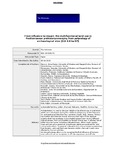From influence to impact: the multifunctional land-use in Mediterranean prehistory emerging from palynology of archaeological sites (8.0-2.8 ka BP)
| dc.contributor.author | Mercuri, AM | |
| dc.contributor.author | Florenzano, A | |
| dc.contributor.author | Burjachs, F | |
| dc.contributor.author | Giardini, M | |
| dc.contributor.author | Kouli, K | |
| dc.contributor.author | Masi, A | |
| dc.contributor.author | Picornell-Gelabert, L | |
| dc.contributor.author | Revelles, J | |
| dc.contributor.author | Servera-Vives, G | |
| dc.contributor.author | Torri, P | |
| dc.contributor.author | Fyfe, R | |
| dc.date.accessioned | 2018-09-05T10:18:40Z | |
| dc.date.issued | 2019-05-01 | |
| dc.identifier.issn | 0959-6836 | |
| dc.identifier.issn | 1477-0911 | |
| dc.identifier.uri | http://hdl.handle.net/10026.1/12228 | |
| dc.description.abstract |
<jats:p> Archaeobotany is used to discover details on local land uses in prehistoric settlements developed during the middle and beginning of late Holocene. Six archaeological sites from four countries (Spain, Italy, Greece, and Turkey) have pollen and charcoal records showing clear signs of the agrarian systems that had developed in the Mediterranean basin during different cultural phases, from pre-Neolithic to Recent Bronze Age. A selected list of pollen taxa and sums, including cultivated trees, other woody species, crops and annual or perennial synanthropic plants are analysed for land use reconstructions. In general, cultivation has a lower image in palynology than forestry, and past land uses became visible when oakwoods were affected by human activities. On-site palynology allows us to recognise the first influence of humans even before it can be recognised in off-site sequences, and off-site sequences can allow us to determine the area of influence of a site. Neolithic and Bronze Age archaeological sites show similar land use dynamics implying oak exploitation, causing local deforestation, and cultivation of cereal fields in the area or around the site. Although a substantial difference makes the Neolithic influence quite distant from the Bronze Age impact, mixed systems of land exploitation emerged everywhere. Multiple land use activities exist (multifunctional landscapes) at the same time within the area of influence of a site. Since the Neolithic, people have adopted a diffuse pattern of land use involving a combination of diverse activities, using trees–crops–domesticated animals. The most recurrent combination included wood exploitation, field cultivation and animal breeding. The lesson from the past is that the multifunctional land use, combining sylvo-pastoral and crop farming mixed systems, has been widely adopted for millennia, being more sustainable than the monoculture and a promising way to develop our economy. </jats:p> | |
| dc.format.extent | 830-846 | |
| dc.language | en | |
| dc.language.iso | en | |
| dc.publisher | SAGE Publications | |
| dc.subject | Bronze Age | |
| dc.subject | charcoal | |
| dc.subject | Holocene | |
| dc.subject | Neolithic | |
| dc.subject | pollen | |
| dc.subject | sustainable farming | |
| dc.title | From influence to impact: the multifunctional land-use in Mediterranean prehistory emerging from palynology of archaeological sites (8.0-2.8 ka BP) | |
| dc.type | journal-article | |
| dc.type | Journal Article | |
| plymouth.author-url | https://www.webofscience.com/api/gateway?GWVersion=2&SrcApp=PARTNER_APP&SrcAuth=LinksAMR&KeyUT=WOS:000468293200009&DestLinkType=FullRecord&DestApp=ALL_WOS&UsrCustomerID=11bb513d99f797142bcfeffcc58ea008 | |
| plymouth.issue | 5 | |
| plymouth.volume | 29 | |
| plymouth.publication-status | Published | |
| plymouth.journal | The Holocene | |
| dc.identifier.doi | 10.1177/0959683619826631 | |
| plymouth.organisational-group | /Plymouth | |
| plymouth.organisational-group | /Plymouth/Admin Group - REF | |
| plymouth.organisational-group | /Plymouth/Admin Group - REF/REF Admin Group - FoSE | |
| plymouth.organisational-group | /Plymouth/Faculty of Science and Engineering | |
| plymouth.organisational-group | /Plymouth/Faculty of Science and Engineering/School of Geography, Earth and Environmental Sciences | |
| plymouth.organisational-group | /Plymouth/REF 2021 Researchers by UoA | |
| plymouth.organisational-group | /Plymouth/REF 2021 Researchers by UoA/UoA14 Geography and Environmental Studies | |
| plymouth.organisational-group | /Plymouth/Research Groups | |
| plymouth.organisational-group | /Plymouth/Research Groups/Marine Institute | |
| plymouth.organisational-group | /Plymouth/Users by role | |
| plymouth.organisational-group | /Plymouth/Users by role/Academics | |
| dcterms.dateAccepted | 2018-08-11 | |
| dc.rights.embargodate | 2019-5-4 | |
| dc.identifier.eissn | 1477-0911 | |
| dc.rights.embargoperiod | Not known | |
| rioxxterms.versionofrecord | 10.1177/0959683619826631 | |
| rioxxterms.licenseref.uri | http://www.rioxx.net/licenses/all-rights-reserved | |
| rioxxterms.licenseref.startdate | 2019-05-01 | |
| rioxxterms.type | Journal Article/Review |


